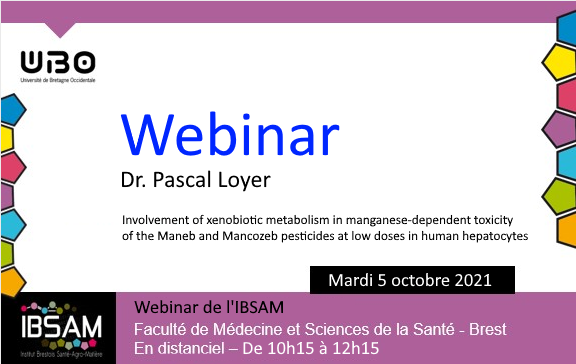
Involvement of xenobiotic metabolism in manganese-dependent
toxicity of the Maneb and Mancozeb pesticides at low doses in human
hepatocytes
Kilian PETITJEAN¹, Yann VERRES¹, Nicolas BRUNO¹, Elise VENE¹, Catherine RIBAULT¹, Olivier HERAULT², Christophe OLIVIER³, Caroline ANINAT¹, Bernard FROMENTY¹, Anne CORLU¹, Pascal LOYER¹
1°) Inserm, INRAE, Univ Rennes, Institut NUMECAN (Nutrition Metabolisms and Cancer) UMR-A 1341, UMR-S
1241, F-35000 Rennes, France
2°) Centre Hospitalier Régional Universitaire de Tours, Service d’Hématologie Biologique, Cedex 9 Tours, National
Center for Scientific Research ERL 7001 LNOx, Université de Tours, Tours, France
3°) Centre de Recherche en Cancérologie Nantes Angers, UMR INSERM 892, CNRS 6299, Université de Nantes,
Service de toxicologie, Faculté de pharmacie de Nantes, Nantes, France
Pesticides remain extensively used in agricultural practices despite the development of alternative methods and evidences that professional exposure is associated with different types of diseases. The worldwide and intensive use of pesticides involves dissemination in rivers, spring water and soils but also in food as residues. Human exposure is therefore a major health issue. European Food Safety Agency stablished for each pesticide an Acceptable Daily Intake (ADI), which is a heoretical safety threshold for human health. Nevertheless, ADI does not consider potential cumulative effects of pesticide cocktails. Our laboratory is involved in a multicenter study that aims at evaluating the effects of a cocktail of 7 pesticides (chorpyriphos, dimethoate, iprodione, imazalil, diazinon, maneb, mancozeb) at low doses using different cell models including hepatic cells. These compounds are found frequently in human food. We have unveiled an important cytotoxicity of the cocktail towards hepatocytes-like HepaRG cells and human hepatocytes in primary culture following a single exposure at low concentrations extrapolated from the ADI. Interestingly, this toxic effect was not found for other hepatic cell lines such as cholangiocyte-like HepaRG cells or non-hepatic cells. This acute exposure triggers ROS overproduction, which leads to cell death by intrinsic apoptosis involving caspases 3 and 9. Moreover, we have demonstrated that the cocktail toxicity is carried by maneb and mancozeb, which both contain a manganese ion. Our investigations also revealed that toxicity is found only in cells etabolizing the 2 pesticides producing nontoxic metabolites and the release of manganese ion, which triggers ROS overproduction and apoptosis. Our results also showed that very low pesticide concentrations (ADI/5 to ADI/25) induce cytotoxicity upon chronic exposure of at least 14 days representing 8 repeated treatments of the cells. In a second part of this work, we demonstrated that the pesticide mixture as well as maneb and mancozeb alone aggravated steatosis induced by oleic and stearic fatty acids in HepaRG cells maintained in culture conditions that slightly reduced the levels of hepatocyte differentiation and the toxicity of the pesticides. Importantly, we found that low dose of pesticides (≤ADI/10) in absence of toxicity, strongly reduced the expression of both CYP2E1 and CYP3A4 at the mRNA levels and the corresponding catalytic activities, while the expression of other markers of liver specific functions such as albumin was not affected upon exposure to the mixture. These data suggest that pesticides and/or metabolites, at very low doses (<ADI), alter the catabolism of xenobiotics in hepatocytes through the down-regulation of phase I enzymes.
Veuillez retrouver le programme complet en pdf :


